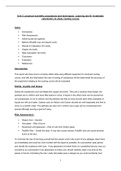Unit 2: practical scientific procedures and techniques. Learning aim B: Undertake
calorimetry to study cooling curves
Index
Introduction,
Risk Assessment,
Solids liquids and gasses,
Method (Paraffin wax and stearic acid),
Results & Calibration (For both),
Graphs (for both),
Rate Calculation (for both),
Conclusion
Evaluation
References
Introduction
This report will show how to correctly obtain data using different equipment to construct cooling
curves, and with this information the rate of cooling of substances will be determined the accuracy of
the experiment relating to the cooling curves will be evaluated.
Solids, Liquids and Gases
Solids are substances such as Metals like copper and silver. They are a compact fixed shape, the
particles are in uniform and have little space to move. A liquid on the other hand can be poured but
not compressed, is not in uniform and the particles are free to move around each other examples of
liquids are milk and water. Gasses such as Helium and Carbon dioxide are well separated and free to
move in a random order. The particles are also not in uniform and a gas can be compressed and
poured although pouring a gas isn’t easy.
Risk Assessment:
Stearic Acid – Harmful
Hot plates – Risk of burns
Equipment and glassware – Risk of cuts from broken glass
Paraffin Wax – Irritate the eyes. It may also cause nausea, Paraffin wax can cause extreme
burns to the skin.
To minimise the risk of harming yourself with the stearic acid in the event of any spillages clean them
up immediately and avoid as much contact with the liquid as possible. As a precaution wear gloves
and handle the substance with care. If any glassware is broken there is a possibility that you may cut
yourself so as a precaution if any glassware is broken you should carefully clean it up and put the
pieces in the bin minimising the risk. Lastly Hot plates pose a danger as you could accidently burn
1
, yourself whilst using them. As a precaution, be careful when using the equipment and when finished
turn it off and leave it to cool before putting it away. Lastly to prevent any harm from the paraffin wax
you should wear eye protection, and be very careful when handling it ensuring that it doesn’t touch
your skin.
Method for paraffin wax:
Substances cool at many different rates. This is because of what they are made of and many
substances change state as they cool for example when wax cools it solidifies, and has gone from a
liquid to a solid. In other words, the particles that were once compact, standardised and in order are
not in uniform and are free to move. A method for cooling and taking the temperature of paraffin wax
as it solidifies is shown below.
Equipment used:
Balance,
Crucible,
Hot Plate,
Heat Proof Mat,
Thermometer (Digital and Analogue),
Probe,
Paraffin Wax.
Stopwatch
Step 1: 3-5g of paraffin wax was weighed out and placed into a crucible ready to be heated.
Step 2: The crucible was then put onto the heat plate with a temperature probe and left until the
wax was completely melted as small bubbles started to appear. The wax was then removed from
the heat plate before it started to boil and placed on a heat proof mat.
Step 3: Then an initial temperature reading was taken and the result was recorded.
Step 4: Next temperature readings were taken and recorded every 30 seconds until the wax
solidified, and the thermometer could no longer be placed into the wax.
Step 5: The results were plotted into a graph and labelled correctly with initial temperature on
the y axis and time in seconds on the x axis. Both sets of results were plotted with the digital and
analogue thermometer readings shown in 2 different colours along with the table results shown
below.
2




